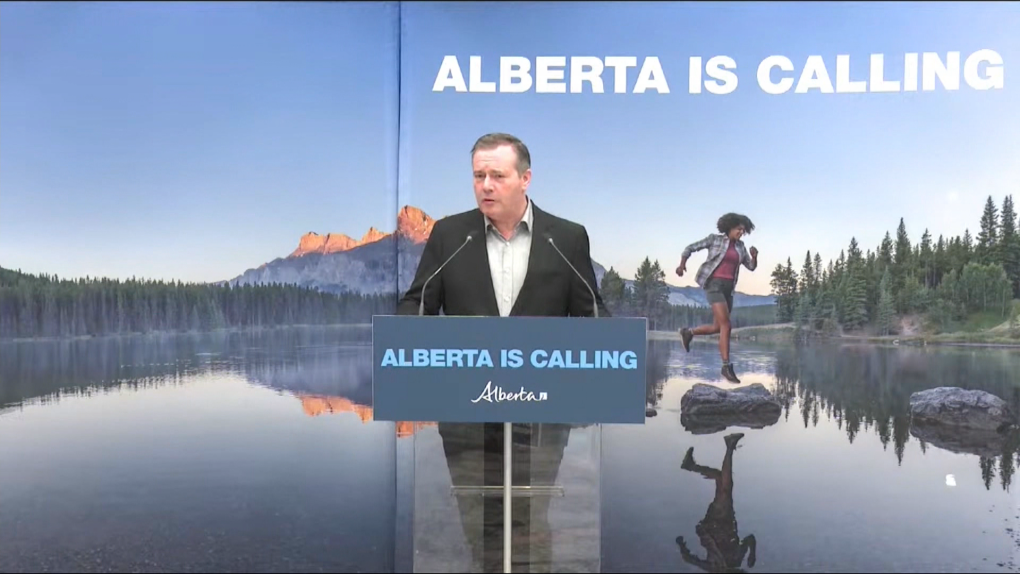Alberta faces multiple challenges supporting population boom: economist
Alberta's been calling for more people to move to the province, and that's what's been happening in droves this past year.
According to Statistics Canada, 194,000 people moved to Wild Rose Country in the last 12 months, upping its population count to 4.7 million — a whopping increase of 4.3 per cent — with many of the newcomers arriving from Ontario and British Columbia.
A spokesperson for the province's ministry of jobs, economy and trade told CTV News Edmonton on Friday the next phase of its Alberta is Calling campaign will focus on attracting skilled-trade workers — welcome news to at least one Edmonton-based construction firm.
"To hear about this provincial initiative is exciting for us," Moe Barzagar, a partner with Hibco Construction, told CTV News Edmonton, adding he hopes the campaign brings in more carpenters, plumbers, electricians and other workers in other specialized trades.
Barzagar said his company is "always" looking to hire skilled workers and has sometimes refused work because of labour shortages.
"We’re going to have to say no to those projects until we have the skilled staff we are confident in to deliver," he said.
 Then-Premier Jason Kenney in Toronto in August 2022 to promote his government's Alberta is Calling marketing campaign. (Credit: Government of Alberta)And while more people are moving to Alberta, one economist wonders if the province is ready to welcome such an increase. While an influx of new residents brings more jobs, more spending and more tax revenue, it also means more demand for services — something the province is already struggling to provide in some areas but also something that is "hopefully" solved over time, says economist Moshe Lander.
Then-Premier Jason Kenney in Toronto in August 2022 to promote his government's Alberta is Calling marketing campaign. (Credit: Government of Alberta)And while more people are moving to Alberta, one economist wonders if the province is ready to welcome such an increase. While an influx of new residents brings more jobs, more spending and more tax revenue, it also means more demand for services — something the province is already struggling to provide in some areas but also something that is "hopefully" solved over time, says economist Moshe Lander.
"It's not just that the province is unprepared to deal with the health care, the education, the roads, infrastructure demand, housing, there are any number of things that they need to be prepared for it," Lander, a member of the economic department at Montreal's Concordia University, told CTV News Edmonton.
"This is not the type of thing that you can just flip a switch and have all of those things ready when you realize that 200,000 people just moved here last year. You need to be preparing for that months, if not years, in advance."
Lander said he expects the trend of more people moving to Alberta — and to Canada in general — to stay the same for the foreseeable future, with people who are affected by the "natural constraints" of the country's largest cities in Toronto, Vancouver and Montreal looking to the second tier of metropolitan areas, including Edmonton and Calgary.
"We could be talking about not just 200,000 people last year, but 200,000 people every year," Lander said.
"This is something that it's not just a matter of hiring a bunch of teachers today or trying to figure out how to expand the Deerfoot or the Whitemud, it's something that has to be done for years worth of planning ... They're way behind on this, and it's not the type of thing that they can just catch up quickly."
 An advertisement from August 2022 funded by the Government of Alberta via its Alberta is Calling marketing campaign. (Credit: Government of Alberta)Whether the Alberta is Calling campaign, which cost the province $4.95 million in 2022-23, is responsible for this past year's population boom is debatable, too, Lander said.
An advertisement from August 2022 funded by the Government of Alberta via its Alberta is Calling marketing campaign. (Credit: Government of Alberta)Whether the Alberta is Calling campaign, which cost the province $4.95 million in 2022-23, is responsible for this past year's population boom is debatable, too, Lander said.
"I’d almost like to see them drop the entire campaign — not because I don’t like it, I just don’t know how much impact it actually has," he said. "As far as (interprovincial) migration goes, most people have heard of Alberta, and they know how great of a place it is for them to live."
He said funding used for such marketing efforts could be used in other ways to help the province better prepare for more residents.
"The money that could be saved there, that's the type of thing then that you can put back into the universities and you can help them try and expand their education departments to make sure they're graduating more teachers, or that you can put into NAIT and SAIT to make sure that they're graduating more people that are working in trades," Lander said.
"It really is an expansion, making sure that when you're funding the universities and when you're funding the various schools, you're making sure that you're funding the right departments."
With files from CTV News Edmonton's Chelan Skulski
CTVNews.ca Top Stories

Poilievre writes to GG calling for House recall, confidence vote after Singh declares he's ready to bring Liberals down
Conservative Leader Pierre Poilievre has written to Gov. Gen. Mary Simon, imploring her to 'use your authority to inform the prime minister that he must' recall the House of Commons so a non-confidence vote can be held. This move comes in light of NDP Leader Jagmeet Singh publishing a letter stating his caucus 'will vote to bring this government down' sometime in 2025.
At least 2 dead and 60 hurt after a car drives into a German Christmas market in a suspected attack
A car plowed into a busy outdoor Christmas market in the eastern German city of Magdeburg on Friday, killing at least two people and injuring at least 60 others in what authorities suspect was an attack.
Judge sentences Quebecer convicted of triple murder who shows 'no remorse'
A Quebecer convicted in a triple murder on Montreal's South Shore has been sentenced to life in prison without chance of parole for 20 years in the second-degree death of Synthia Bussieres.
'I understand there's going to be a short runway,' new minister says after Trudeau shuffles cabinet
Prime Minister Justin Trudeau added eight Liberal MPs to his front bench and reassigned four ministers in a cabinet shuffle in Ottawa on Friday. But as soon as they were sworn-in, they faced questions about the political future of their government, and their leader.
Speeding drivers get holiday surprise from 'Officer Grinch'
Drivers in the Florida Keys who exceed the speed limit in school zones may run into a well-known gloomy green creature and get a surprising 'gift.'
Poilievre to Trump: 'Canada will never be the 51st state'
Conservative leader Pierre Poilievre is responding to U.S. president-elect Donald Trump’s ongoing suggestions that Canada become the 51st state, saying it will 'never happen.'
Kelly Clarkson's subtle yet satisfying message to anyone single this Christmas
The singer and daytime-talk show host released a fireside video to accompany her 2021 holiday album, “When Christmas Comes Around” that she dubbed, “When Christmas Comes Around…Again.
16-year-old German exchange student dies after North Vancouver crash
A 16-year-old high school student from Germany who was hit by a Jeep in North Vancouver, B.C., last weekend has died in hospital, authorities confirmed.
Canadiens executive says he has 'no concern' about members of the front office traveling to Russia
Montreal executive vice president of hockey operations Jeff Gorton said he has “no concern” about members of the Canadiens’ front office travelling to Russia with the country’s war in Ukraine ongoing.

































